Empirical Modeling of Radiowave Angular Power Distributions in Different Propagation Environments at 60 GHz for 5G
Abstract
:1. Introduction
- 1–10 Gbps connections to end points in the field
- 1 ms end-to-end round-trip delay (latency)
- 1000x bandwidth per unit area
- 10–100x connected devices
- (Perception of) 99.999% availability
- (Perception of) 100% coverage
- 90% reduction in network energy usage
- Up to ten years of battery life for low power, machine-type devices
2. Experimental Set-Up
2.1. Measurement System
2.2. Measurement Scenarios
3. Results: APDs
4. Discussion
4.1. APD Model
4.2. Improvement by Angular Combining
5. Conclusions
Author Contributions
Funding
Conflicts of Interest
References
- GSMA Intelligence Analysis. Understanding 5G: Perspectives on Future Technological Advancements in Mobile; White Paper: London, UK, 2014. [Google Scholar]
- Andrews, J.G.; Buzzi, S.; Choi, W.; Hanly, S.V.; Lozano, A.; Soong, A.C.K.; Zhang, J.C. What will 5G be? IEEE J. Sel. Areas Commun. 2014, 32, 1065–1082. [Google Scholar] [CrossRef]
- International Wireless Industry Consortium. Evolutionary & Disruptive Visions Towards Ultra High Capacity Networks; White Paper: Doylestown, PA, USA, 2014. [Google Scholar]
- Rappaport, T.S.; Sun, S.; Mayzus, R.; Zhao, H.; Azar, Y.; Wang, K.; Wong, G.N.; Schulz, J.K.; Samimi, M.; Gutierrez, F. Millimeter wave mobile communications for 5G cellular: It will work! IEEE Access 2013, 1, 335–349. [Google Scholar] [CrossRef]
- An, X.; Sum, C.; Prasad, R.V.; Wang, J.; Lan, Z.; Wang, J.; Hekmat, R.; Harada, H.; Niemegeers, I. Beam switching support to resolve link-blockage problem in 60 GHz WPANs. In Proceedings of the 2009 IEEE 20th International Symposium on Personal, Indoor and Mobile Radio Communications, Tokyo, Japan, 13–16 Septemper 2009; pp. 390–394. [Google Scholar]
- Roh, W.; Seol, J.; Park, J.; Lee, B.; Lee, J.; Kim, Y.; Cho, J.; Cheun, K.; Aryanfar, F. Millimeter-wave beamforming as an enabling technology for 5G cellular communications: Theoretical feasibility and prototype results. IEEE Commun. Mag. 2014, 52, 106–113. [Google Scholar] [CrossRef]
- Larsson, E.; Edfors, O.; Tufvesson, F.; Marzetta, T. Massive MIMO for next generation wireless Systems. IEEE Commun. Mag. 2014, 52, 186–195. [Google Scholar] [CrossRef]
- Hassan, N.; Fernando, X. Massive MIMO Wireless Networks: An Overview. Electronics 2017, 6, 63. [Google Scholar] [CrossRef]
- Pinchera, D.; Migliore, M.D.; Schettino, F.; Panariello, D. Antenna Arrays for Line-of-Sight Massive MIMO: Half Wavelength Is Not Enough. Electronics 2017, 6, 57. [Google Scholar] [CrossRef]
- Fan, W.; Carton, I.; Kyosti, P.; Karstensen, A.; Jamsa, T.; Gustafsson, M.; Pedersen, G.F. A step toward 5G in 2020: Low-cost OTA performance evaluation of massive MIMO base stations. IEEE Antennas Propag. Mag. 2017, 59, 38–47. [Google Scholar] [CrossRef]
- Hur, S.; Baek, S.; Kim, B.; Park, J.; Molisch, A.F.; Haneda, K.; Peter, M. 28 GHz channel modeling using 3D ray-tracing in urban environments. In Proceedings of the 9th EuCAP, Lisbon, Portugal, 12–17 April 2015. [Google Scholar]
- Hur, S.; Baek, S.; Kim, B.; Chang, Y.; Molisch, A.F.; Rappaport, T.S.; Haneda, K.; Park, J. Proposal on millimeter-wave channel modeling for 5G cellular system. IEEE J. Sel. Top. Signal Process. 2016, 10, 454–469. [Google Scholar] [CrossRef]
- Kyösti, P.; Jämsä, T.; Nuutinen, J.P. Channel modelling for multiprobe over-the-air MIMO testing. Int. J. Antennas Propag. 2012. [Google Scholar] [CrossRef]
- Smulders, P.F.M.; Correia, L.M. Characterisation of propagation in 60 GHz radio channels. Electron. Commun. Eng. J. 1997, 9, 73–80. [Google Scholar] [CrossRef]
- Hammoudeh, A.M.; Sánchez, M.G.; Grindrod, E. Experimental analysis of propagation at 62 GHz in suburban mobile radio microcells. IEEE Trans. Veh. Technol. 1999, 48, 576–588. [Google Scholar] [CrossRef]
- Xu, H.; Kukshya, V.; Rappaport, T.S. Spatial and temporal characteristics of 60-GHz indoor channels. IEEE J. Sel. Areas Commun. 2002, 20, 620–630. [Google Scholar] [CrossRef] [Green Version]
- Smulders, P.F.M. Statistical characterization of 60-GHz indoor radio channels. IEEE Trans. Antennas Propag. 2009, 57, 2820–2829. [Google Scholar] [CrossRef]
- Geng, S.; Kivinen, J.; Zhao, X.; Vainikainen, P. Millimeter-wave propagation channel characterization for short-range wireless communications. IEEE Trans. Veh. Technol. 2009, 58, 3–13. [Google Scholar] [CrossRef]
- Ben-Dor, E.; Rappaport, T.S.; Qiao, Y.; Lauffenburger, S.J. Millimeter-wave 60 GHz outdoor and vehicle AOA propagation measurements using a broadband channel sounder. In Proceedings of the IEEE GLOBECOM, Houston, TX, USA, 5–9 December 2011; pp. 1–6. [Google Scholar]
- Rappaport, T.S.; Ben-Dor, E.; Murdock, J.N.; Qiao, Y. 38 GHz and 60 GHz angle-dependent propagation for cellular & peer-to-peer wireless communications. In Proceedings of the 2012 IEEE International Conference on Communications (ICC), Ottawa, ON, Canada, 10–15 June 2012; pp. 4568–4573. [Google Scholar]
- Lu, J.S.; Cabrol, P.; Steinbach, D.; Pragada, R.V. Measurement and characterization of various outdoor 60 GHz diffracted and scattered paths. In Proceedings of the IEEE MILCOM, San Diego, CA, USA, 18–20 November 2013. [Google Scholar]
- Lemos, E.; Táboas, M.P.; Sánchez, M.G.; Alejos, A.V. Microcellular Radio Channel Characterization at 60 GHz for 5G communications. IEEE Antennas Wirel. Propag. Lett. 2017, 16, 1476–1479. [Google Scholar]
- Wang, C.; Bian, J.; Sun, J.; Zhang, W.; Zhang, M. A survey of 5G channel measurements and models. IEEE Commun. Surv. Tutor. 2018, 20, 3142–3168. [Google Scholar] [CrossRef]
- Sun, S.; Rappaport, T.S.; Shafi, M.; Tang, P.; Zhang, J.; Smith, P.J. Propagation models and performance evaluation for 5G millimeter-wave bands. IEEE Trans. Veh. Technol. 2018, 67, 8422–8439. [Google Scholar] [CrossRef]
- METIS. METIS Channel Models. ICT-317669 METIS Project. 2015. Available online: https://www.metis2020.com/wp-content/uploads/METIS_D1.4_v3.pdf (accessed on 27 November 2018).
- Medbo, J.; Kyosti, P.; Kusume, K.; Raschkowski, L.; Haneda, K.; Jamsa, T.; Nurmela, V.; Roivainen, A.; Meinila, J. Radio propagation modeling for 5G mobile and wireless communications. IEEE Commun. Mag. 2016, 54, 144–151. [Google Scholar] [CrossRef]
- Liu, L.; Oestges, C.; Poutanen, J.; Haneda, K.; Vainikainen, P.; Quitin, F.; Tufvesson, F.; de Doncker, P. The COST 2100 MIMO channel model. IEEE Wirel. Commun. Mag. 2012, 19, 92–99. [Google Scholar] [CrossRef] [Green Version]
- IST-WINNER II Deliverable 1.1.2 v.1.2. WINNER II Channel Models. IST-WINNER2, Technical Report. 2007. Available online: https://www.cept.org/files/8339/winner2 - final report.pdf (accessed on 27 November 2018).
- 3GPP. Study on Channel Model for Frequencies from 0.5 to 100 GHz. Technical Report 3GPP TR 38.901 V15.0.0 (2018-06), Release 15. Available online: www.3gpp.org/DynaReport/38901.htm (accessed on 27 November 2018).
- Saleh, A.A.M.; Valenzuela, R. A statistical model for indoor multipath propagation. IEEE J. Sel. Areas Commun. 1987, 5, 128–137. [Google Scholar] [CrossRef]
- Spencer, Q.H.; Jeffs, B.D.; Jensen, M.A.; Swindlehurst, A.L. Modeling the statistical time and angle of arrival characteristics of an indoor multipath channel. IEEE J. Sel. Areas Commun. 2000, 18, 347–360. [Google Scholar] [CrossRef] [Green Version]
- Samimi, M.K.; Rappaport, T.S. 3-D millimeter-wave statistical channel model for 5G wireless system design. IEEE Trans. Microw. Theory Tech. 2016, 64, 2207–2225. [Google Scholar] [CrossRef]
- Ziolkowski, C.; Kelner, J.M. Empirical models of the azimuthal reception angle—Part I: Comparative analysis of empirical models for different propagation environments. Wirel. Pers. Commun. 2016, 91, 771–791. [Google Scholar] [CrossRef]
- Perget, F. Performance evaluation on beamforming solutions for mmwave wireless systems. In Proceedings of the 2011 IEEE Global Telecommunications Conference—GLOBECOM 2011, Houston, TX, USA, 5–9 December 2011. [Google Scholar]
- Wyne, S. Beamforming effects on measured mm-wave channel characteristics. IEEE Trans. Wirel. Commun. 2011, 10, 3553–3559. [Google Scholar] [CrossRef]
- Sun, S.; Rappaport, T.S. Multi-beam antenna combining for 28 GHz cellular link improvement in urban environments. In Proceedings of the 2013 IEEE Global Telecommunications Conference—GLOBECOM 2013, Atlanta, GA, USA, 9–13 December 2013; pp. 3754–3758. [Google Scholar]
- Sun, S.; MacCartney, G.R.; Samimi, M.K.; Nie, S.; Rappaport, T.S. Millimeter wave multi-beam antenna combining for 5G cellular link improvement in New York City. In Proceedings of the 2014 IEEE International Conference on Communications (ICC), Sydney, NSW, Australia, 10–14 June 2014; pp. 5468–5472. [Google Scholar]
- Lemos, E.; Sánchez, M.G.; Alejos, A.V. High speed transmission at 60 GHz for 5G communications. In Proceedings of the IEEE APS-URSI, Vancouver, BC, Canada, 19–24 July 2015; pp. 1007–1008. [Google Scholar]
- Sánchez, M.G.; Portela, M.; Lemos, E. Millimeter wave radio channel characterization for 5G vehicle-to-vehicle communications. Measurements 2017, 95, 223–229. [Google Scholar]
- Samimi, M.; Wang, K.; Azar, Y.; Wong, G.N.; Mayzus, R.; Zhao, H.; Schulz, J.K.; Sun, S.; Gutierrez, F.; Rappaport, T.S. 28 GHz angle of arrival and angle of departure analysis for outdoor cellular communications using steerable beam antennas in New York City. In Proceedings of the 77th IEEE VTC (Spring), Dresden, Germany, 2–5 June 2013. [Google Scholar]
- Sulyman, A.I.; Alwarafy, A.; MacCartney, G.R.; Rappaport, T.S. Directional radio propagation path loss models for millimeter-wave wireless networks in the 28-, 60-, and 73-GHz bands. IEEE Trans. Wirel. Commun. 2016, 15, 6939–6947. [Google Scholar] [CrossRef]
- ITU-R P.1057-5, Probability Distributions Relevant to Radiowave Propagation Modelling. December 2017. Available online: https://www.itu.int/rec/R-REC-P.1057-5-201712-I (accessed on 27 November 2018).
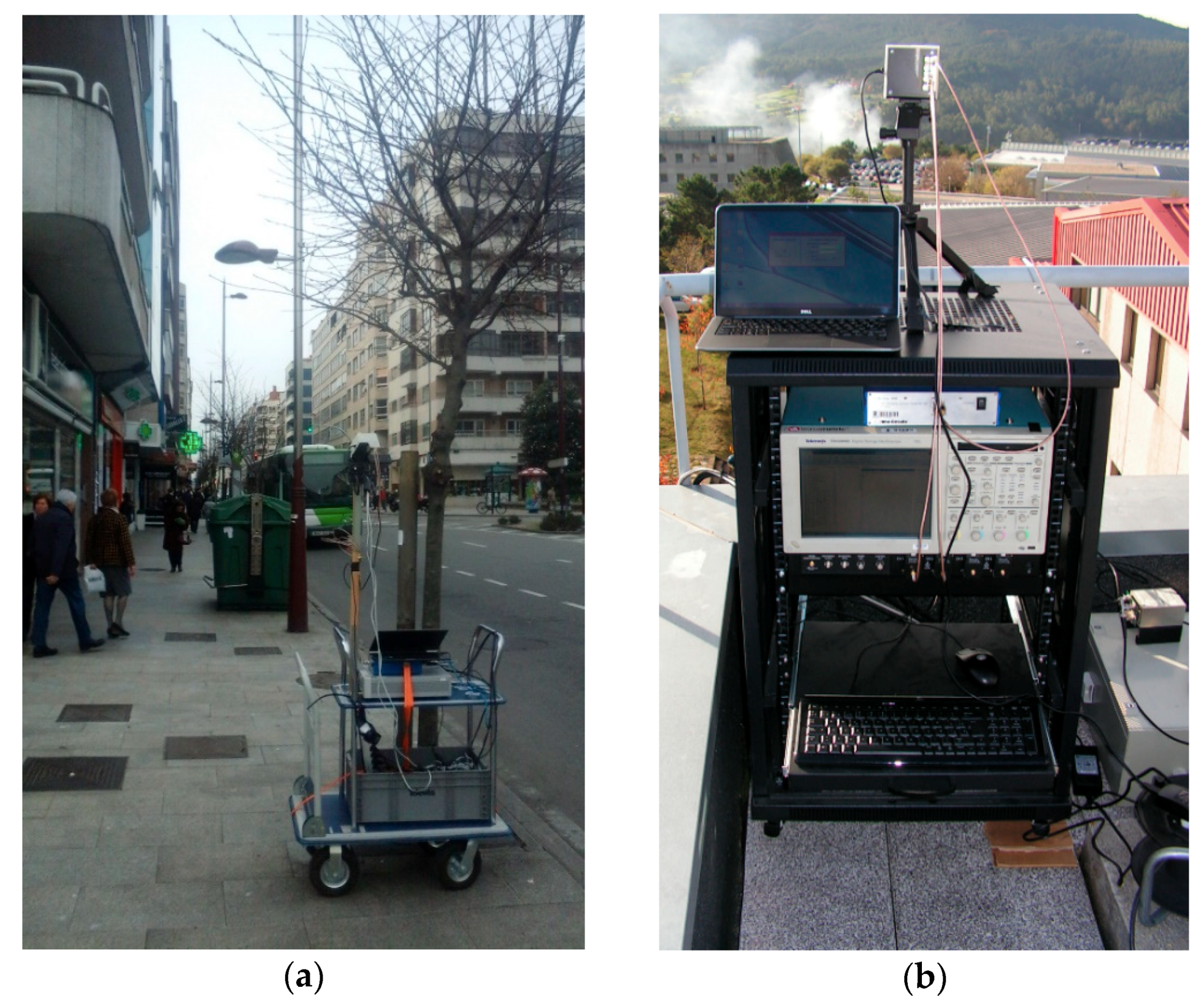
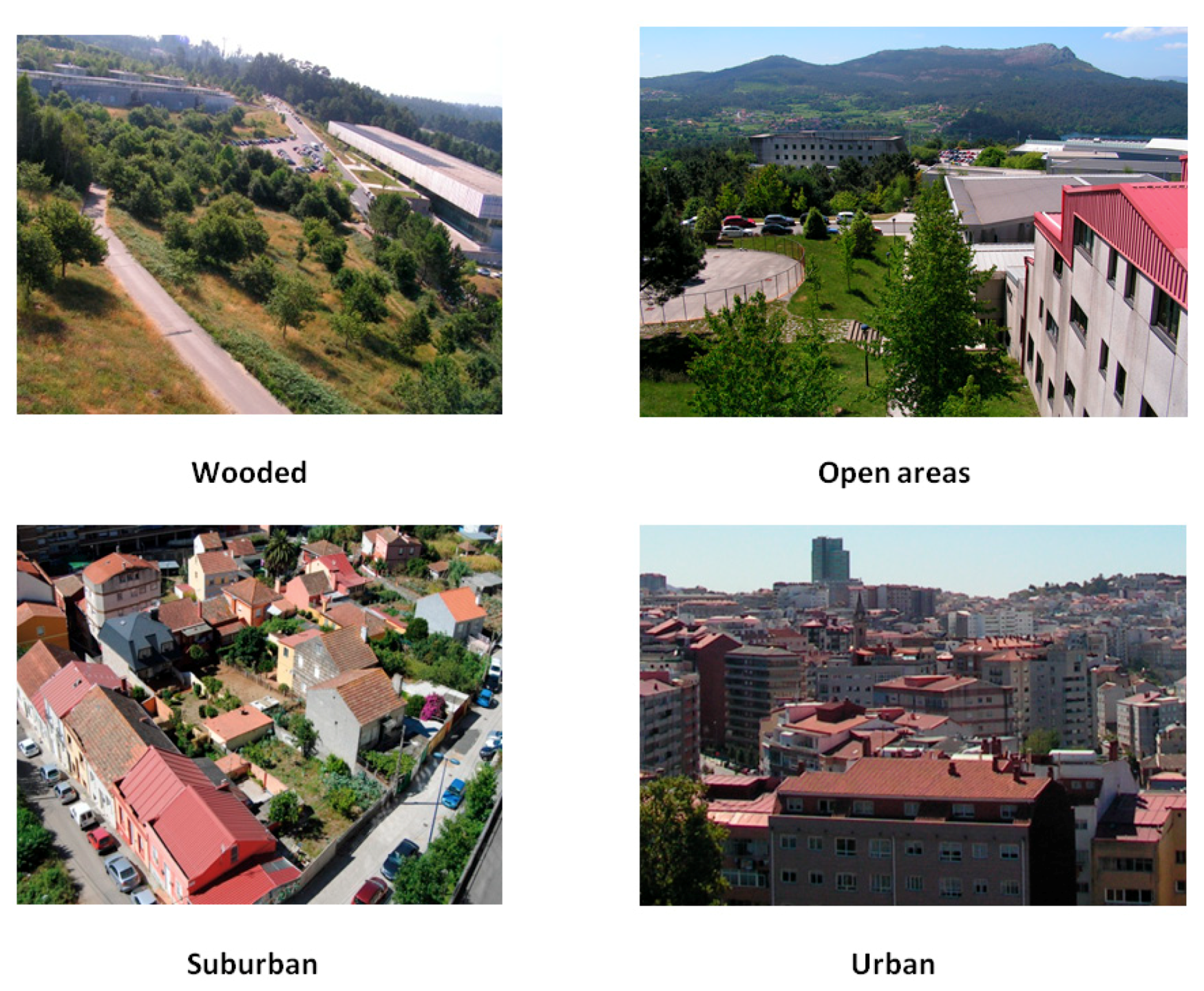
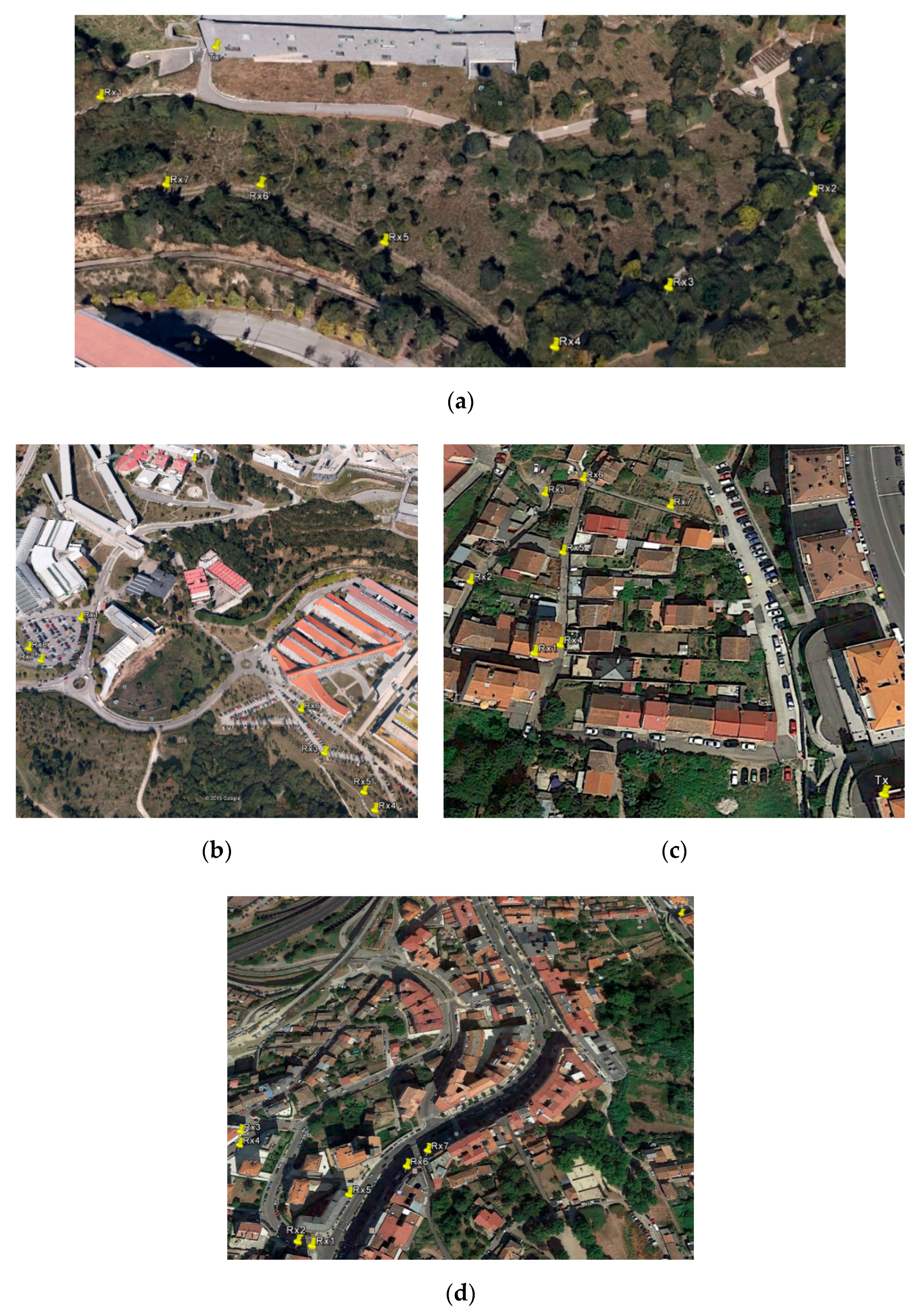

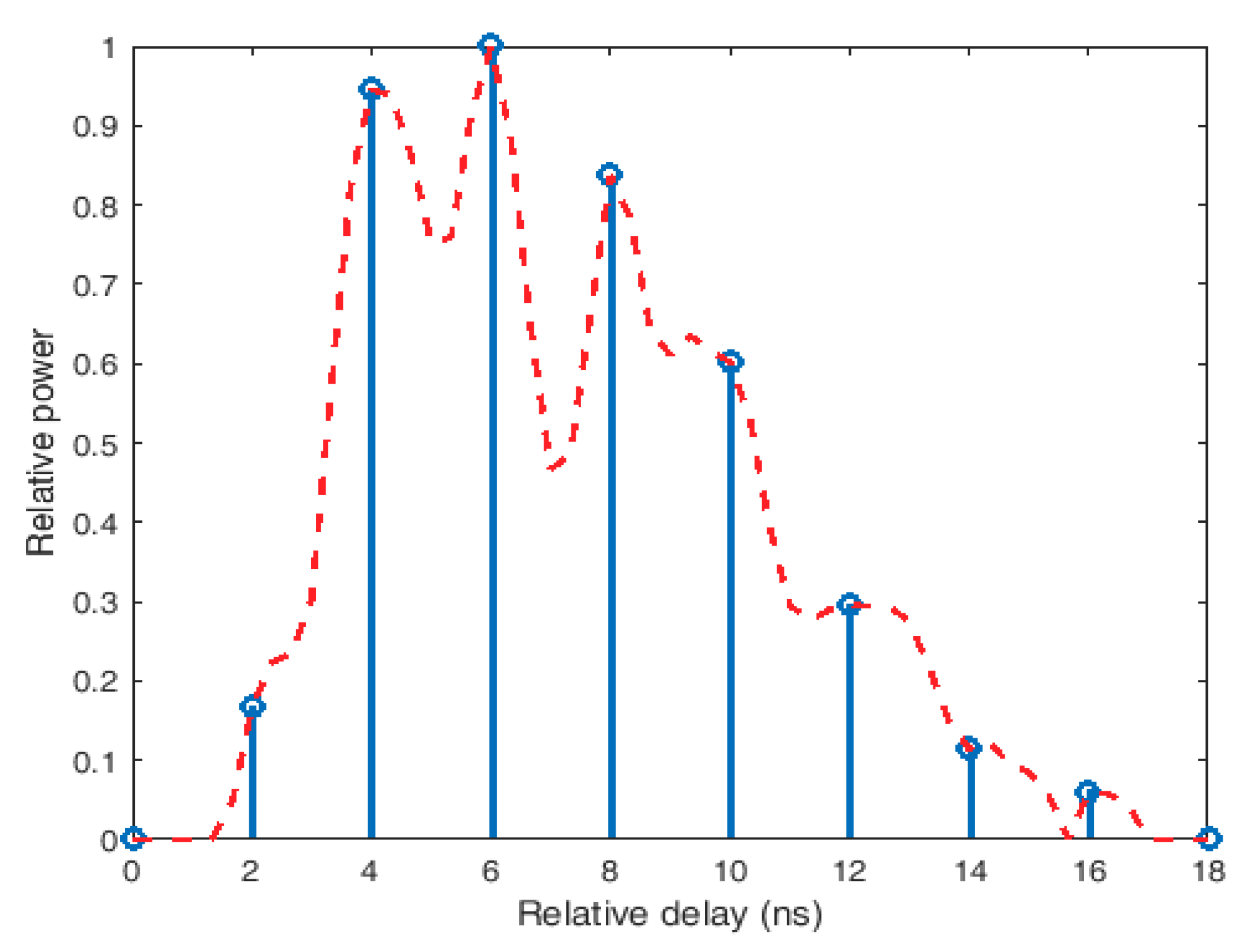

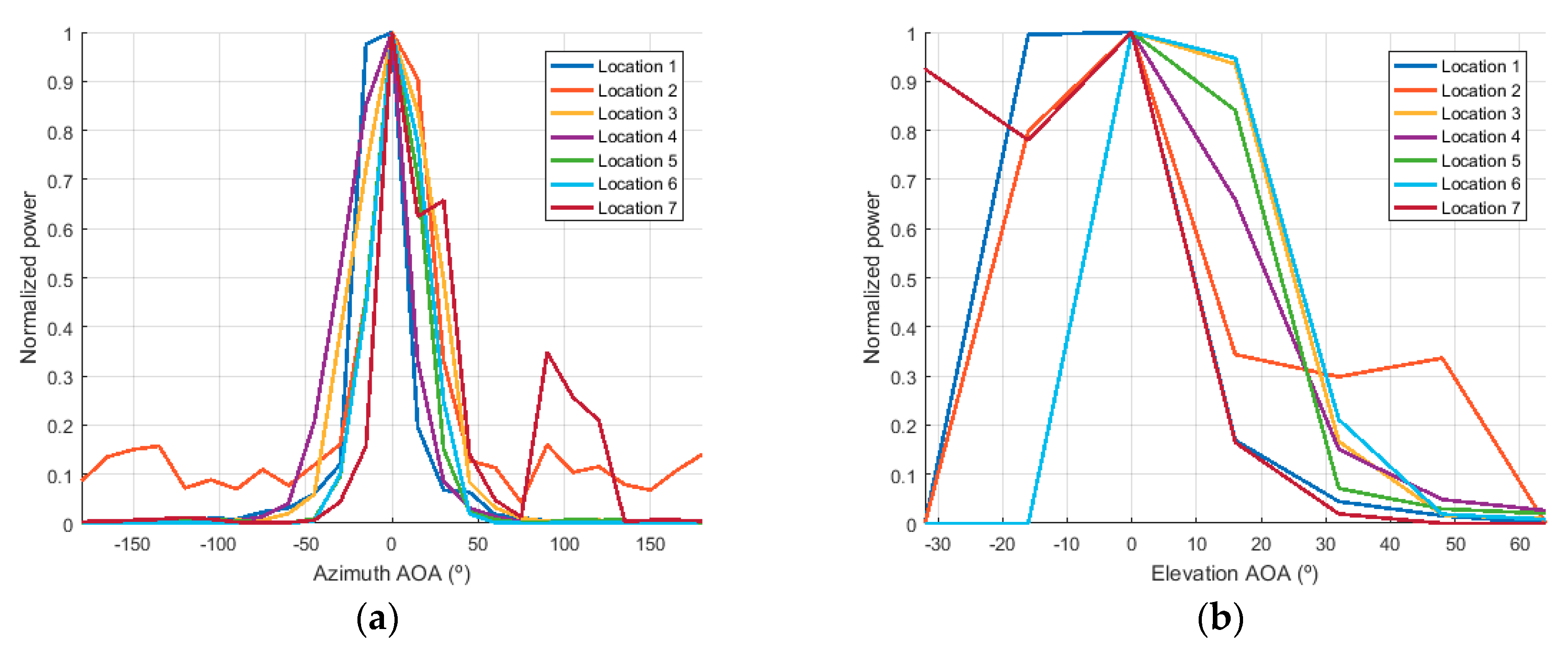

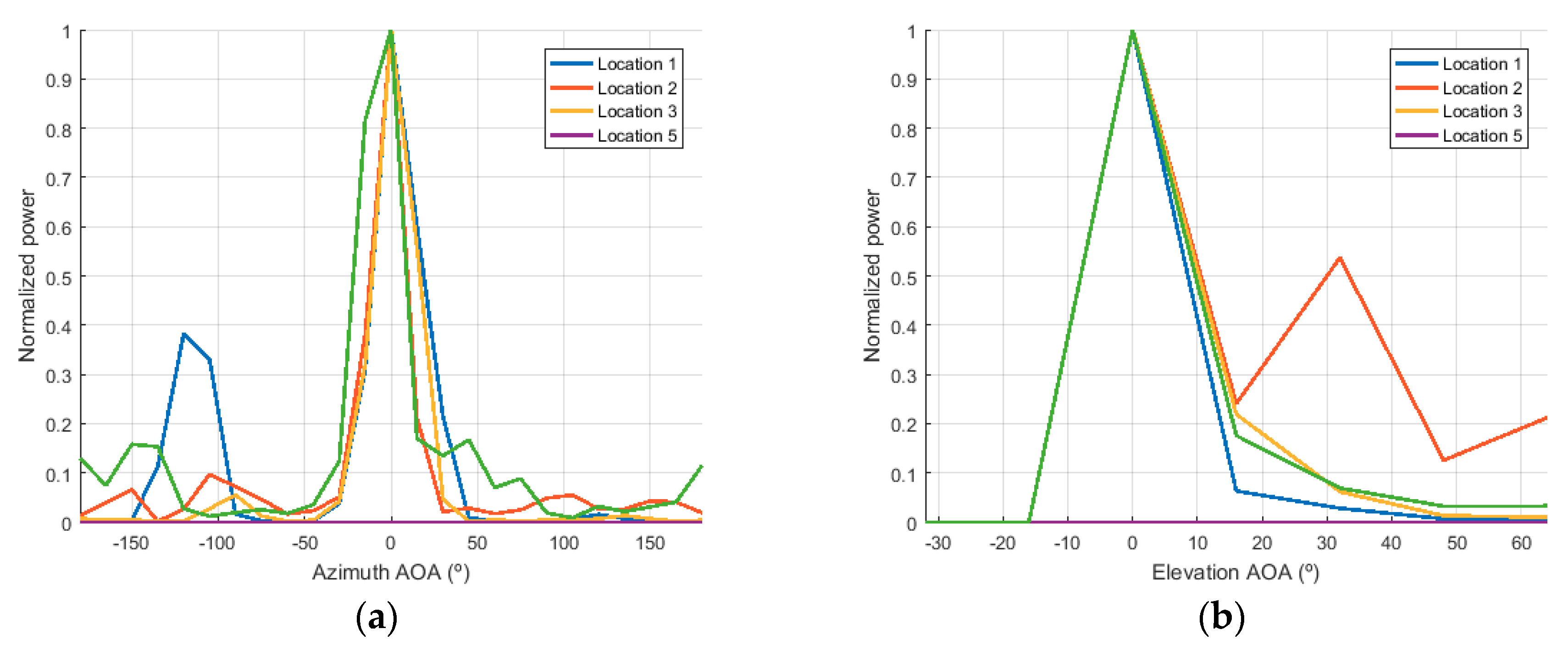

| Parameter | Value |
|---|---|
| Frequency | 60.48 GHz |
| PRBS chip rate (fc) | 500 Mbps |
| RF bandwidth (null-to-null) | 1 GHz |
| Code length | 213 − 1 bit |
| Multipath time resolution | 2 ns |
| Max. Tx power | 15 dBm |
| Max. measurable path loss (10 dB SNR) | 150 dB |
| Tx/Rx antenna polarization | Vertical |
| Tx/Rx antenna gain | 20 dBi |
| Tx/Rx antenna azimuth 3 dB beamwidth | 18° |
| Tx/Rx antenna elevation 3 dB beamwidth | 19° |
| Environment | Open | Wooded | Suburban | Urban |
|---|---|---|---|---|
| Tx–Rx distance range (m) | [250, 550] | [50, 200] | [30, 200] | [350, 500] |
| Rx height (m) | 12 | 14 | 33 | 33 |
| Tx height (m) | 1.8 | 1.8 | 1.8 | 1.8 |
| Tx–Rx angle range | [6°, 10°] | [13°, 32°] | [11°, 36°] | [5°, 7°] |
| Environment | Open | Wooded | Suburban | Urban | |||||
|---|---|---|---|---|---|---|---|---|---|
| Number of SLs | μ | 1 | 1.71 | 1 | 1.4 | ||||
| σ | 0 | 1.50 | 0.63 | 1.14 | |||||
| AoA | Az. | El. | Az. | El. | Az. | El. | Az. | El. | |
| LAS (degrees) | μ | 49.3 | 23.6 | 58.8 | 49.3 | 52.5 | 33.7 | 47.1 | 37.5 |
| σ | 7.3 | 8.0 | 29.0 | 14.3 | 8.2 | 7.5 | 23.6 | 26.0 | |
| rms LAS (degrees) | μ | 11.5 | 3.2 | 14.6 | 12.9 | 11.8 | 8.7 | 11.6 | 9.7 |
| σ | 0.9 | 3.0 | 4.6 | 3.8 | 1.5 | 1.7 | 3.8 | 7.5 | |
| Environment | Open | Wooded | Suburban | Urban | |
|---|---|---|---|---|---|
| GCC (dB) | μ | 0 | 1.5 | 1.2 | 2.2 |
| σ | 0 | 2.8 | 2.7 | 2.5 | |
| GNCC (dB) | μ | 0 | 0.4 | 0.6 | 0.6 |
| σ | 0 | 0.7 | 1.3 | 0.7 | |
© 2018 by the authors. Licensee MDPI, Basel, Switzerland. This article is an open access article distributed under the terms and conditions of the Creative Commons Attribution (CC BY) license (http://creativecommons.org/licenses/by/4.0/).
Share and Cite
García Sánchez, M.; Lemos Cid, E.; Vázquez Alejos, A. Empirical Modeling of Radiowave Angular Power Distributions in Different Propagation Environments at 60 GHz for 5G. Electronics 2018, 7, 365. https://doi.org/10.3390/electronics7120365
García Sánchez M, Lemos Cid E, Vázquez Alejos A. Empirical Modeling of Radiowave Angular Power Distributions in Different Propagation Environments at 60 GHz for 5G. Electronics. 2018; 7(12):365. https://doi.org/10.3390/electronics7120365
Chicago/Turabian StyleGarcía Sánchez, Manuel, Edgar Lemos Cid, and Ana Vázquez Alejos. 2018. "Empirical Modeling of Radiowave Angular Power Distributions in Different Propagation Environments at 60 GHz for 5G" Electronics 7, no. 12: 365. https://doi.org/10.3390/electronics7120365






